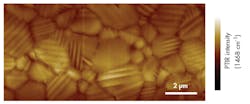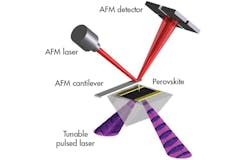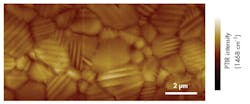Exploring Perovskites: The Keys to Better Solar Cells
A special class of perovskites—those consisting of a hybrid of organic and inorganic components—convert sunlight into electricity with an efficiency above 20% and are easier to fabricate and more impervious to defects than standard solar cells made of crystalline silicon. (Most perovskites consist of a calcium titanium oxide mineral.) As fabricated today, however, organic/inorganic perovskites (OIPs) deteriorate well before the typical 30-year lifetime for silicon cells, which prevents their widespread use in harnessing solar power.
Now a team of engineers from the National Institute of Standards and Technology (NIST) and the University of Nebraska has found the first solid evidence for a property of OIPs that may provide a new way to improve their long-term stability as solar cells. The unexpected feature the team found is known as ferroelasticity—a spontaneous rearrangement of the OIP’s internal structure in which each crystal subdivides into a series of tiny regions, or domains, that have the same atomic arrangement but are oriented in different directions. This rearrangement creates a spontaneous strain in each domain that exists even in the absence of any external stress (force).
At high temperatures, OIP crystals do not subdivide and consist solely of the same cubic arrangement of atoms. At room temperature, however, their crystal structure changes from cubic to tetragonal, in which one axis of the cube elongates. That’s where the ferroelastic property of the material comes into play.
At present, no one knows if ferroelasticity improves or hinders the performance and stability of perovskite solar cells. But boundaries between crystals—so-called inter-grain boundaries—are known to be weak points where structural defects concentrate. Similarly, boundaries between the newly discovered ferroelastic domains inside a single crystal—intra-grain boundaries—might also affect the stability of OIPs and their performance as solar cells.
The researchers discovered that by bending the crystals, they could reliably move, create, or eliminate the ferroelastic grain boundaries—the borders between subdivided crystal regions having different orientations—thus enlarging or reducing the size of each domain. The bending also changed the relative fraction of domains pointing in different orientations.
In their study, the team found no evidence that OIPs were ferroelectric. In other words, they did not form domains where the separation of the center of positive and negative electric charges is aligned in different directions in the absence of an external electric field. This finding is significant because some researchers speculated that ferroelectricity might be why OIPs make promising candidates for solar cells.
The researchers created single whole crystals large enough to reveal ferroelastic domains, which appeared as striations with an optical microscope. They also studied OIPs consisting of polycrystalline thin films, which were examined using nanoscale techniques.



